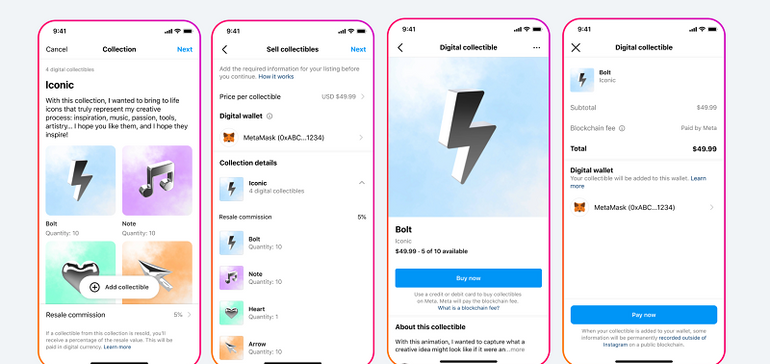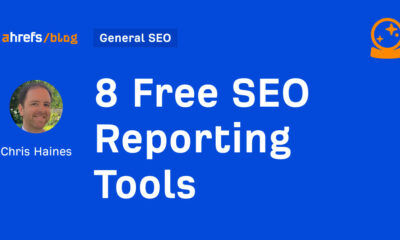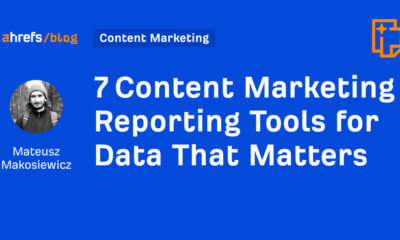SOCIAL
Meta Announces New Creator Monetization Tools, Including Subscriptions on IG and new NFT Options

It’s Creator Week at Meta, and along with various showcase events and panels, Meta has also announced some new features for creators, including expanded monetization opportunities, and new tools to facilitate creation and selling of NFTs.
First off, Instagram’s making fan subscriptions available to all eligible creators in the US, which will enable a lot more people to monetize their Instagram audience via direct, ongoing support from their communities.
Instagram first launched fan subscriptions with selected creators back in January, as part of its expanding suite of creator monetization tools, which are designed to keep top talent aligned to its app.
With subscriptions, creators (with over 10k followers) are able to charge a monthly fee – between $0.99 and $99.99 – which then gives paying members access to subscribers-only live-streams, subscribers-only posts and Stories and badges in comment streams to help creators identify their supporters.
Instagram takes no cut from subscriber revenue at this stage, though any fees paid are subject to Google and Apple’s 30% in fees for in-app purchases. But outside of that, any money raised is yours, which provides another avenue for creators to make money from their IG content.
Meta’s also launching new gifts in Instagram Reels, which will enable viewers to send virtual Gifts to Reels creators, which then allocate the cost of that gift as a donation.

So it’s like Facebook Stars, but in a different form, with these more illustrative, animated gift types potentially drawing more attention and engagement.
Meta’s testing gifts on Reels in the US to begin with, before considering broader expansion.
Speaking of Stars, over on Facebook, more creators will now also be able to access its fan donation feature, which enables your supporters to allocate funds to you during videos and live-streams.

Meta’s also testing automatic Stars onboarding for creators, meaning the ability to receive Stars will automatically appear on their content, while it’s also making Stars available on photo and text posts, in addition to videos, live-streams and Reels (Facebook added Stars for Reels back in August).
Also, ‘Stars Party on Reels’
“Stars Party is a celebratory moment that happens when a spike of Stars are sent from your fans on live or reels. When the spike occurs, an overlay with a countdown will appear on the screen with a progress toward a goal, encouraging fans to send Stars and meet the Stars goal.”
Lastly, Meta’s looking to lean further into NFTs and digital art, via a new process which will enable users to both create and sell NFTs within Instagram.

Meta says that creators will have ‘an end-to-end toolkit’ to facilitate NFT trading, with fans and collectors able to purchase digital collectibles directly within Instagram.
In addition, Meta’s also testing video digital collectibles on Instagram, and adding support for the Solana blockchain and Phantom wallet, in addition to the blockchains and wallets that it already supports.
NFTs will also now be enhanced with additional metadata from OpenSea to provide further context.
I’m still not sure that NFTs are going to be the transformative vehicle for artists that some had initially projected at the start of the boom period last year, but there is a clear niche interest in these artworks as collectible pieces, and as such, it makes sense for Instagram to lean into this, and facilitate engagement for the NFT community.
At the same time, Meta’s also eyeing a bigger user case for the underlying NFT process, in trading virtual items and digital goods that could theoretically be used and displayed within the metaverse.
If the metaverse does become a thing, as Meta anticipates, then buying and selling digital items will become a much bigger deal too, and with that in mind, integrating NFT processes, and engagement around digital goods, could be another step towards the next stage of online interaction.
These are some interesting additions, which contribute to Meta’s broader strategy to build better monetization opportunities for creators, in order to keep them posting, and building in their apps.
Meta also knows that it needs creators to lead its metaverse shift. The metaverse, as Meta envisions, will provide all-new opportunities for all types of creators to build entirely new experiences – and it’s those new, unique activations that will entice more people to buy into VR, and follow these creators through to the next stage.
That’s why Meta’s making creators a focus, and why enhanced monetization is key to its longer-term push.
SOCIAL
Snapchat Explores New Messaging Retention Feature: A Game-Changer or Risky Move?

In a recent announcement, Snapchat revealed a groundbreaking update that challenges its traditional design ethos. The platform is experimenting with an option that allows users to defy the 24-hour auto-delete rule, a feature synonymous with Snapchat’s ephemeral messaging model.
The proposed change aims to introduce a “Never delete” option in messaging retention settings, aligning Snapchat more closely with conventional messaging apps. While this move may blur Snapchat’s distinctive selling point, Snap appears convinced of its necessity.
According to Snap, the decision stems from user feedback and a commitment to innovation based on user needs. The company aims to provide greater flexibility and control over conversations, catering to the preferences of its community.
Currently undergoing trials in select markets, the new feature empowers users to adjust retention settings on a conversation-by-conversation basis. Flexibility remains paramount, with participants able to modify settings within chats and receive in-chat notifications to ensure transparency.
Snapchat underscores that the default auto-delete feature will persist, reinforcing its design philosophy centered on ephemerality. However, with the app gaining traction as a primary messaging platform, the option offers users a means to preserve longer chat histories.
The update marks a pivotal moment for Snapchat, renowned for its disappearing message premise, especially popular among younger demographics. Retaining this focus has been pivotal to Snapchat’s identity, but the shift suggests a broader strategy aimed at diversifying its user base.
This strategy may appeal particularly to older demographics, potentially extending Snapchat’s relevance as users age. By emulating features of conventional messaging platforms, Snapchat seeks to enhance its appeal and broaden its reach.
Yet, the introduction of message retention poses questions about Snapchat’s uniqueness. While addressing user demands, the risk of diluting Snapchat’s distinctiveness looms large.
As Snapchat ventures into uncharted territory, the outcome of this experiment remains uncertain. Will message retention propel Snapchat to new heights, or will it compromise the platform’s uniqueness?
Only time will tell.
SOCIAL
Catering to specific audience boosts your business, says accountant turned coach

While it is tempting to try to appeal to a broad audience, the founder of alcohol-free coaching service Just the Tonic, Sandra Parker, believes the best thing you can do for your business is focus on your niche. Here’s how she did just that.
When running a business, reaching out to as many clients as possible can be tempting. But it also risks making your marketing “too generic,” warns Sandra Parker, the founder of Just The Tonic Coaching.
“From the very start of my business, I knew exactly who I could help and who I couldn’t,” Parker told My Biggest Lessons.
Parker struggled with alcohol dependence as a young professional. Today, her business targets high-achieving individuals who face challenges similar to those she had early in her career.
“I understand their frustrations, I understand their fears, and I understand their coping mechanisms and the stories they’re telling themselves,” Parker said. “Because of that, I’m able to market very effectively, to speak in a language that they understand, and am able to reach them.”Â
“I believe that it’s really important that you know exactly who your customer or your client is, and you target them, and you resist the temptation to make your marketing too generic to try and reach everyone,” she explained.
“If you speak specifically to your target clients, you will reach them, and I believe that’s the way that you’re going to be more successful.
Watch the video for more of Sandra Parker’s biggest lessons.
SOCIAL
Instagram Tests Live-Stream Games to Enhance Engagement

Instagram’s testing out some new options to help spice up your live-streams in the app, with some live broadcasters now able to select a game that they can play with viewers in-stream.
As you can see in these example screens, posted by Ahmed Ghanem, some creators now have the option to play either “This or That”, a question and answer prompt that you can share with your viewers, or “Trivia”, to generate more engagement within your IG live-streams.
That could be a simple way to spark more conversation and interaction, which could then lead into further engagement opportunities from your live audience.
Meta’s been exploring more ways to make live-streaming a bigger consideration for IG creators, with a view to live-streams potentially catching on with more users.
That includes the gradual expansion of its “Stars” live-stream donation program, giving more creators in more regions a means to accept donations from live-stream viewers, while back in December, Instagram also added some new options to make it easier to go live using third-party tools via desktop PCs.
Live streaming has been a major shift in China, where shopping live-streams, in particular, have led to massive opportunities for streaming platforms. They haven’t caught on in the same way in Western regions, but as TikTok and YouTube look to push live-stream adoption, there is still a chance that they will become a much bigger element in future.
Which is why IG is also trying to stay in touch, and add more ways for its creators to engage via streams. Live-stream games is another element within this, which could make this a better community-building, and potentially sales-driving option.
We’ve asked Instagram for more information on this test, and we’ll update this post if/when we hear back.
-

 PPC6 days ago
PPC6 days ago19 Best SEO Tools in 2024 (For Every Use Case)
-
SEARCHENGINES5 days ago
Daily Search Forum Recap: April 19, 2024
-
SEARCHENGINES6 days ago
Daily Search Forum Recap: April 18, 2024
-

 WORDPRESS6 days ago
WORDPRESS6 days agoHow to Make $5000 of Passive Income Every Month in WordPress
-

 SEO7 days ago
SEO7 days ago2024 WordPress Vulnerability Report Shows Errors Sites Keep Making
-

 WORDPRESS7 days ago
WORDPRESS7 days ago10 Amazing WordPress Design Resouces – WordPress.com News
-

 SEO6 days ago
SEO6 days ago25 WordPress Alternatives Best For SEO
-

 WORDPRESS5 days ago
WORDPRESS5 days ago7 Best WooCommerce Points and Rewards Plugins (Free & Paid)














You must be logged in to post a comment Login